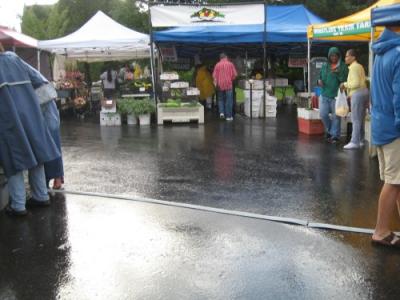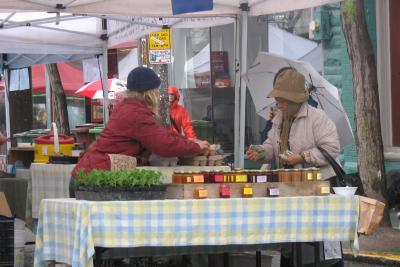
Braving the elements to build the local economy
 Winter farmers’ markets are tests of fortitude and patience, even in Seattle, where the climate is reasonably temperate much of the season. Vendors weather the rain and wind, enduring slow sales waiting for the occasional brilliant day when the sun and the customers show. Those of us who set up our tents on bleak January days don’t expect long lines or strong sales; we’re working together to maintain an enterprise that relies on our consistent turnout and ongoing participation: if a critical mass of vendors show up even on the darkest, rainiest days, then the few customers who do make the trek will find what they need, and they’ll be willing to turn out again next time.
Winter farmers’ markets are tests of fortitude and patience, even in Seattle, where the climate is reasonably temperate much of the season. Vendors weather the rain and wind, enduring slow sales waiting for the occasional brilliant day when the sun and the customers show. Those of us who set up our tents on bleak January days don’t expect long lines or strong sales; we’re working together to maintain an enterprise that relies on our consistent turnout and ongoing participation: if a critical mass of vendors show up even on the darkest, rainiest days, then the few customers who do make the trek will find what they need, and they’ll be willing to turn out again next time.
Some vendors drive just a few miles to the markets; others travel hours from the other end of the state, weathering mountain passes even in the dead of January. The fertile valleys around the town of Carnation, about an hour east of the city, don’t get much snow but they do flood, stranding farmers and forcing them to miss markets. The town of Sequim, to the west, enjoys a disproportionate amount of winter sunshine; farmers from that area pile market tables high with colorful greens and crimson beets, supplementing the scarcity from other parts of the state.
Some days we sell out and drive home tired and happy; other days we come away chilled and bone tired without breaking even. Solidarity is strongest on the grimmest days. We entertain each other, sharing the warmth of stoves and war stories from our darkest market days. And we barter, trading our bounty and getting to know each other’s needs and preferences. In fact, the worst days for sales tend to be the best days for bartering because we have more time to visit and exchange, and more product that needs to find a home.
 Few farmers’ markets are formally organized as cooperatives, yet farmers’ markets are deeply cooperative endeavors. Vendors collaborate to build a thriving marketplace, a whole that is bigger, stronger, and more interesting than the sum of its individual parts. Like members of producer coops, we own our own enterprises, yet together we create a more complex business that transcends each of our individual contributions and draws on our individual and collective strengths.
Few farmers’ markets are formally organized as cooperatives, yet farmers’ markets are deeply cooperative endeavors. Vendors collaborate to build a thriving marketplace, a whole that is bigger, stronger, and more interesting than the sum of its individual parts. Like members of producer coops, we own our own enterprises, yet together we create a more complex business that transcends each of our individual contributions and draws on our individual and collective strengths.
The cooperative dimension of Northwest farmers’ market culture especially shines when we deal with regulatory agencies, especially the health department. Some of the agency’s actions and regulations feel draconian at times, yet vendors understand that a foodborne illness traced directly to a farmers’ market stand would devastate business, not only at the market where the incident occurred, but at all markets throughout the region, -- and even across the country.
We keep our stalls clean and our food safe because we don’t want to sicken our customers, and also because we share a responsibility to one another. Several years ago, when a local newspaper published a sensationalist article about health code violations at local farmers’ markets, we enlisted the support of other media outlets as well as the local health department to make the case for our compliance and our integrity. This past fall, when the health department floated the prospect of raising fees for farmers’ market vendors by nearly 50 percent, we wrote letters, attended meetings, and rallied public support to steer the agency towards a more sensible, sustainable solution to its cash flow shortfalls.
Solidarity is strongest on the grimmest days.
There are dozens of farmers’ markets throughout the Seattle area. Some are serious shopping events, with customers who turn out early on weekend mornings knowing exactly which stalls they will visit and what they will buy. Other markets are more like weekly neighborhood parties, with music, kids’ activities, and extensive dinner options. Vendors see each other at multiple locations throughout the week, and we share our impressions and our experiences.
Some markets are organized by nonprofit organizations working for the good of the community. They tend to be well run, albeit a bit heavy on rules. Other markets are run by representatives of municipal governments; these events can be awkward, top-down hybrids run by administrators with little knowledge of food or understanding of vendor culture. Most market vendors agree that the best markets are run by current or past vendors, people who have spent time behind a market table through sunny and inclement days, people who understand the mission and the passion, and know how to balance the needs of the vendors with the needs of the customers to create a vibrant, exciting marketplace.
Go to the Regional Cooperative/Solidarity Economy Networks theme page
Go to the GEO front page
Citations
Devra Gartenstein (2015). Vendor Solidarity at Seattle-Area Farmers' Markets: Braving the elements to build the local economy. Grassroots Economic Organizing (GEO). https://geo.coop/story/vendor-solidarity-seattle-area-farmers-markets

Add new comment